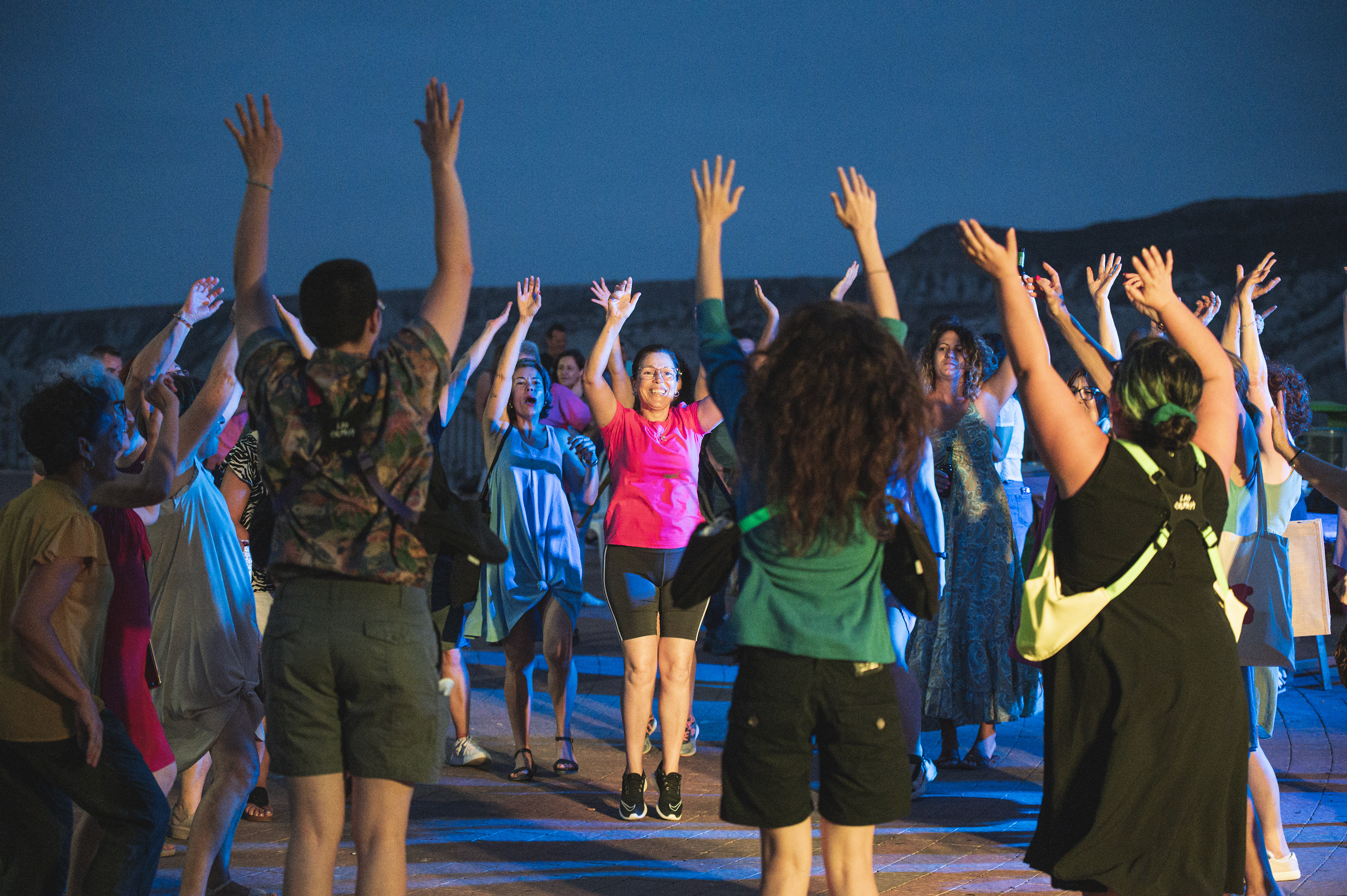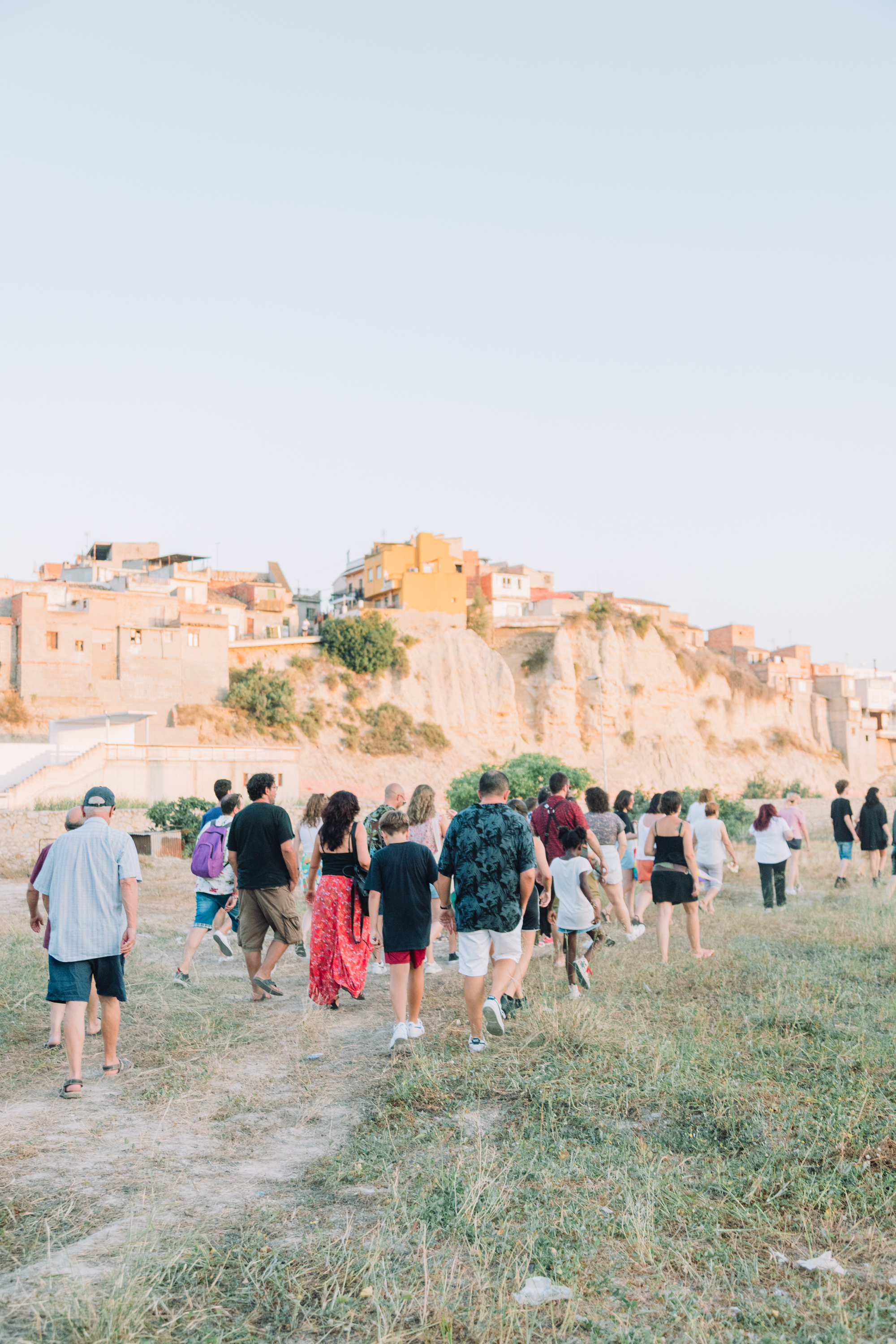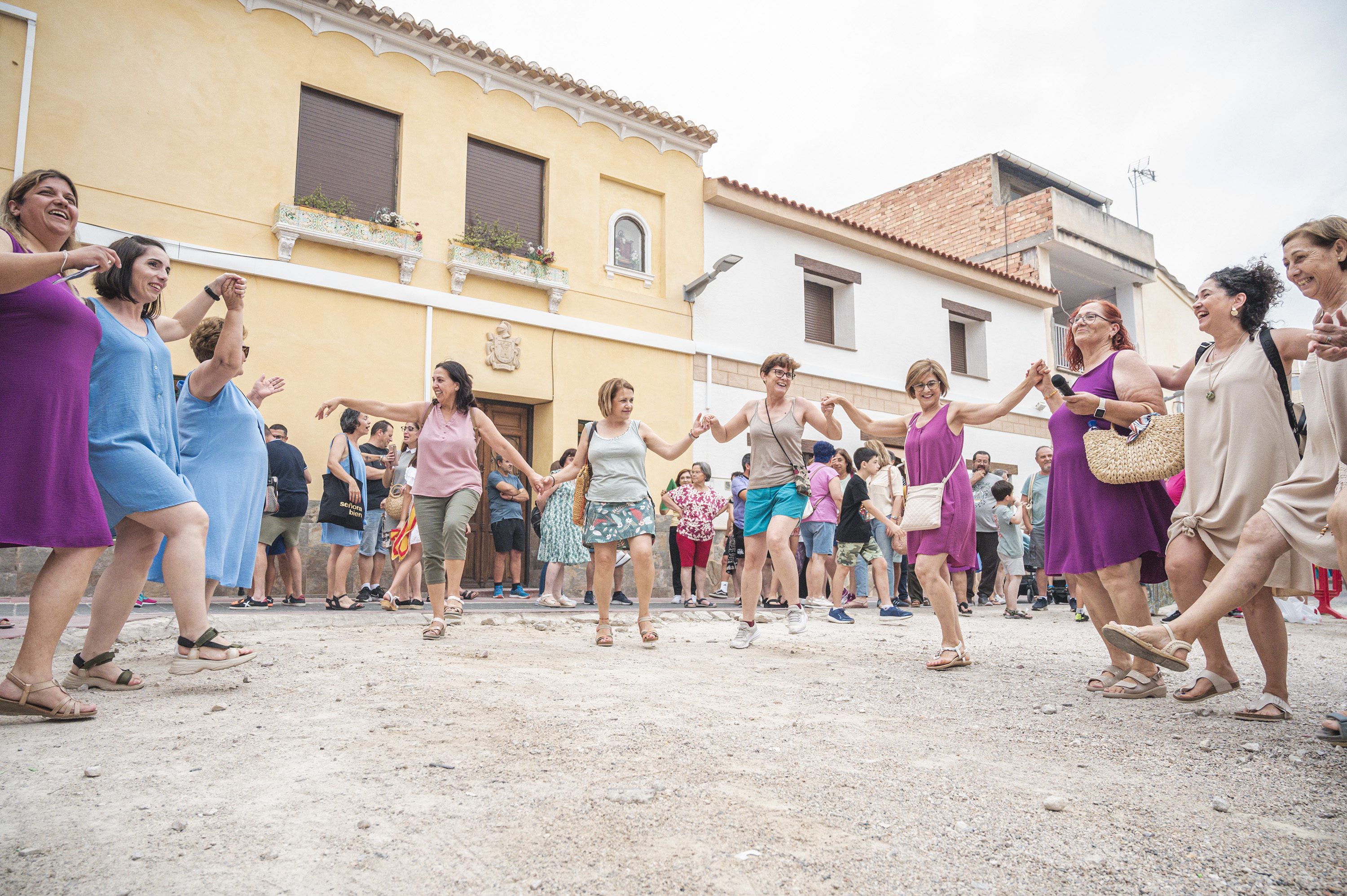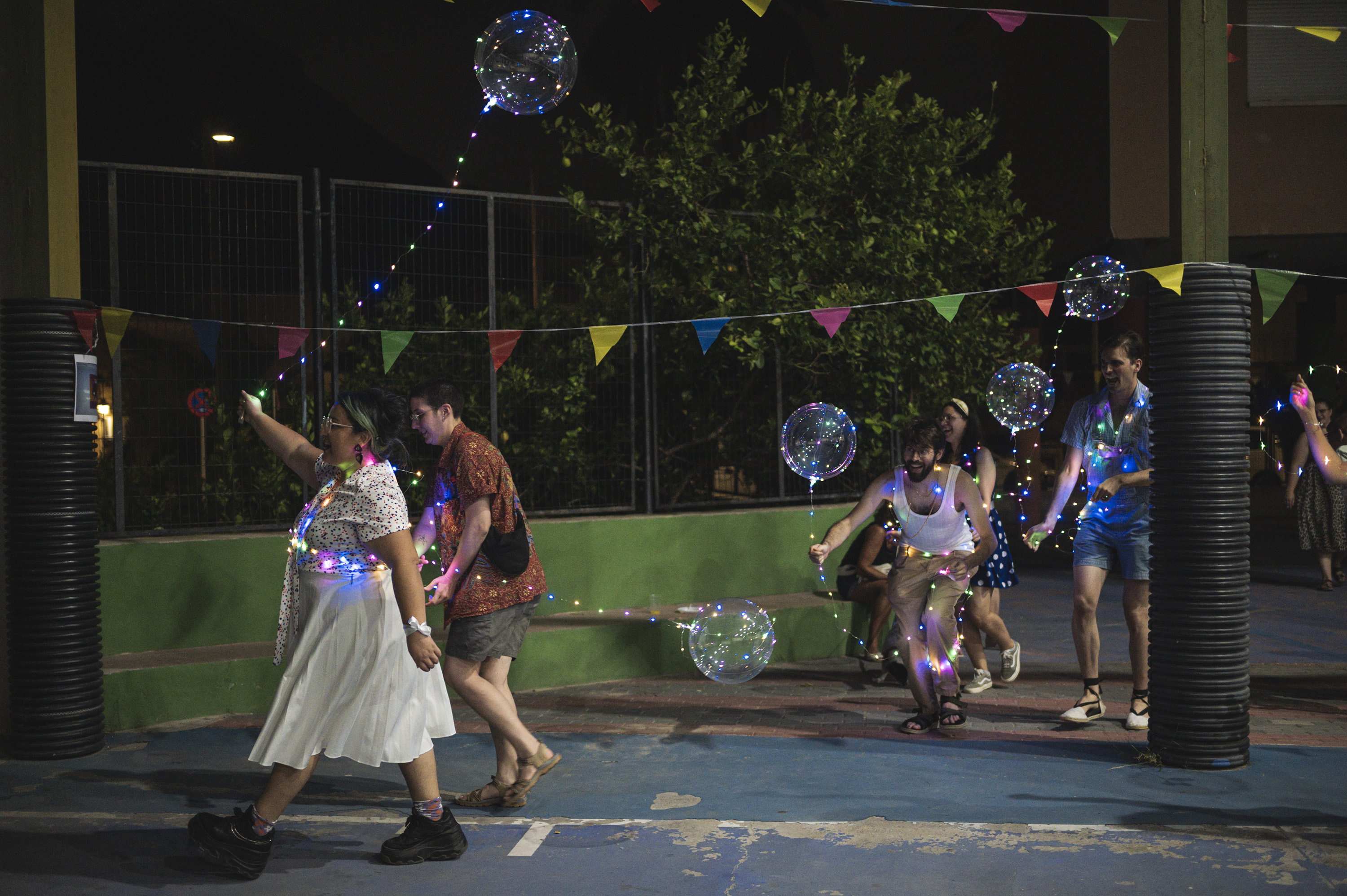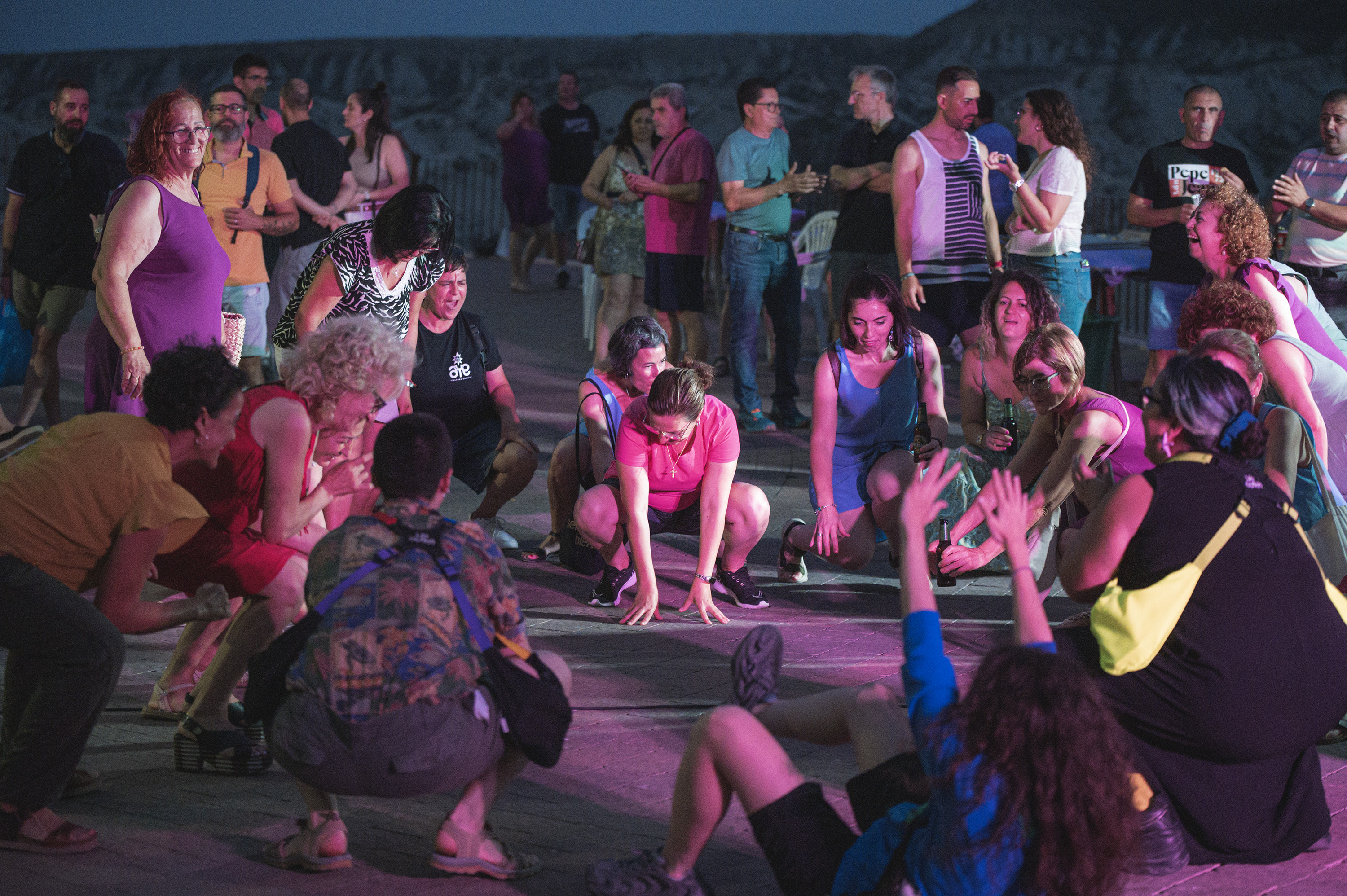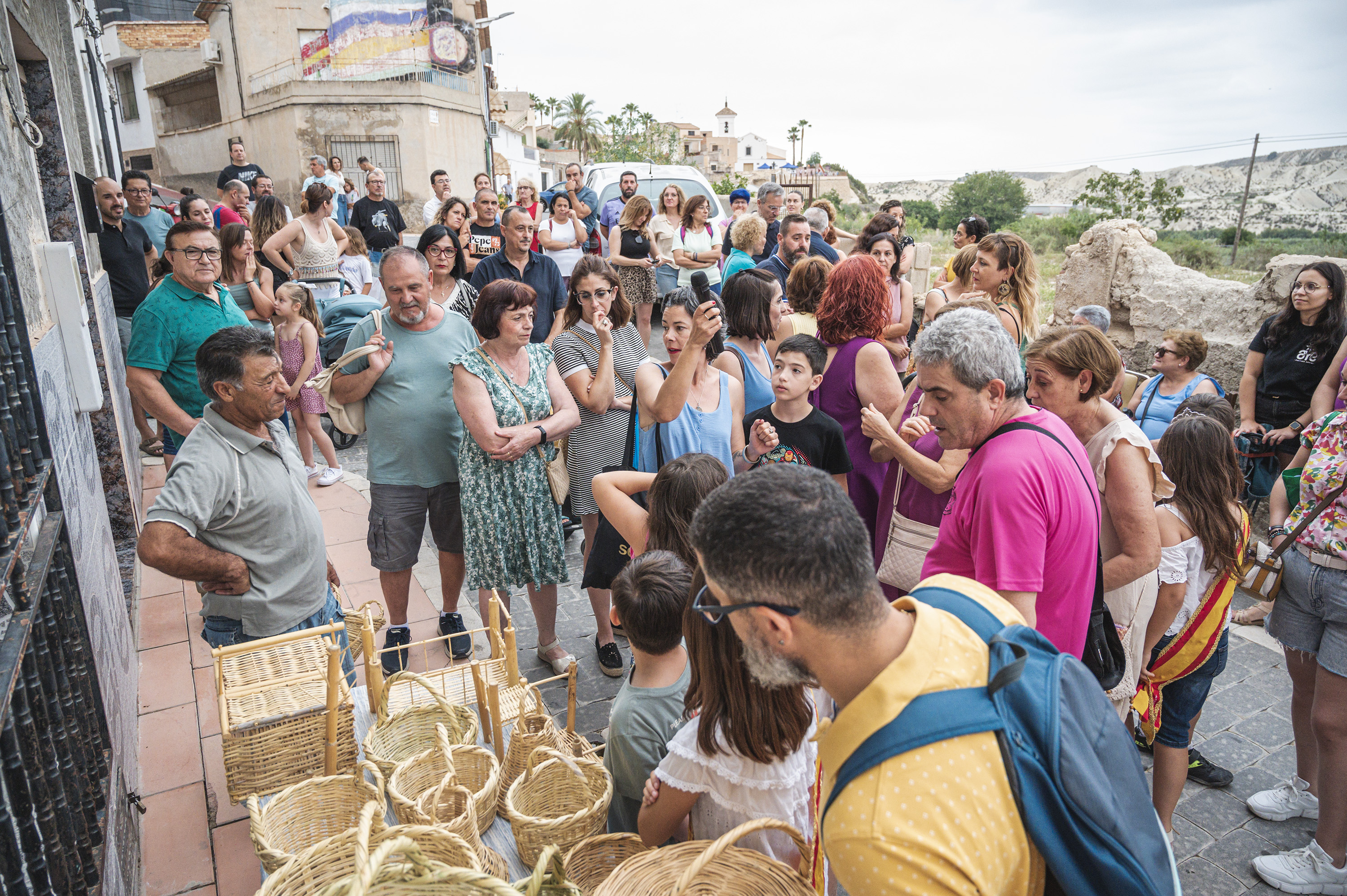Regaining a sense of belonging
La Gritaera
La Gritaera: cultural movement in rural environments
"La Gritaera" aims to shake up the cultural landscape of the rural areas of the Region of Murcia, areas characterized by demographic risk, precarious living and social conditions.The loss, as a society, of cultural values, identity, and a collective sense of belonging.
This cultural mediation project in rural areas aims to promote access to Cultural Rights in the territory and contemporary models, while also fostering intergenerational exchange and revitalizing other sectors.
This cultural mediation project in rural areas aims to promote access to Cultural Rights in the territory and contemporary models, while also fostering intergenerational exchange and revitalizing other sectors.
Spain
Regional
Campos del Río, Albudeite, Ricote and Ojós
Mainly rural
It refers to other types of transformations (soft investment)
Yes
2023-09-01
No
No
Yes
Yes
Yes
As a representative of an organisation
La Gritaera aims to promote artistic activity, creation, practices and contemporary cultural processes in close connection with the communities and their contexts, contributing to a conversation between the contemporary and the traditional, placing value on the roots of the territory and its traditional knowledge.
To help build new narratives, imaginaries, representations, aesthetics, values and attitudes for the rural environment, reconciling the challenges posed by the contemporary world with rural identity and traditional practices.
This practicies develop strategies to fight the gentrification on cities and promote diversification of culture, conomy and social engagement on rural areas, this will bring sustainable options to rethink our models of housing and living. We also worked on values of gender equality and diversity, cultural diversity and affective-sexual diversity in the municipality.
Stir up and energise the cultural sector, stimulating citizen participation, especially youth participation and dialogue, as an instrument of democratic participation, well-being, health and social and territorial cohesion.
To ensure that the project is designed using participatory methods, a diagnosis of the cultural needs and concerns of the municipality has been carried out in each territory, through meetings with the technicians of the City Council, the associations of the territory, young people, women and citizens in general, as well as the constitution of a driving group in each territory.To create democratic cultural agents and mediators committed to the rural territory.
To help build new narratives, imaginaries, representations, aesthetics, values and attitudes for the rural environment, reconciling the challenges posed by the contemporary world with rural identity and traditional practices.
This practicies develop strategies to fight the gentrification on cities and promote diversification of culture, conomy and social engagement on rural areas, this will bring sustainable options to rethink our models of housing and living. We also worked on values of gender equality and diversity, cultural diversity and affective-sexual diversity in the municipality.
Stir up and energise the cultural sector, stimulating citizen participation, especially youth participation and dialogue, as an instrument of democratic participation, well-being, health and social and territorial cohesion.
To ensure that the project is designed using participatory methods, a diagnosis of the cultural needs and concerns of the municipality has been carried out in each territory, through meetings with the technicians of the City Council, the associations of the territory, young people, women and citizens in general, as well as the constitution of a driving group in each territory.To create democratic cultural agents and mediators committed to the rural territory.
Sustainable
Participation
Culture
Exchange
Belonging
The "La Gritaera" project aligns with the values of sustainability, as promoted by the New European Bauhaus, through its integration of cultural, social, and environmental dimensions in rural areas. Its key objectives in terms of sustainability are as follows:
-Cultural Sustainability: The project bridges the contemporary and traditional, fostering cultural exchange that enhances both rural identity and modern cultural practices. By valuing the material and immaterial heritage of the region, it ensures that local traditions are preserved, revitalized, and shared through public art and community-based activities, contributing to the long-term cultural vitality of rural areas.
-Social Sustainability: It promotes inclusivity by working with diverse community groups, including women, youth, and marginalized individuals. The project strengthens social cohesion by creating opportunities for participation and collaboration, thus fostering a sense of belonging and community ownership. It encourages democratic engagement through citizen-driven cultural creation and dialogue, strengthening social ties and intergenerational relationships.
-Environmental Sustainability: The project incorporates sustainable practices by creating art that is site-specific and interacts with the natural environment. The use of local materials and a focus on the heritage of rural landscapes help reduce the environmental footprint while also raising awareness of local ecological challenges and sustainable practices.
-Economic Sustainability: The project stimulates local economies by promoting rural tourism, supporting local artists, and encouraging community-driven economic activities. By emphasizing the connection between culture, heritage, and tourism, it provides sustainable economic opportunities for small municipalities with limited resources.
-Cultural Sustainability: The project bridges the contemporary and traditional, fostering cultural exchange that enhances both rural identity and modern cultural practices. By valuing the material and immaterial heritage of the region, it ensures that local traditions are preserved, revitalized, and shared through public art and community-based activities, contributing to the long-term cultural vitality of rural areas.
-Social Sustainability: It promotes inclusivity by working with diverse community groups, including women, youth, and marginalized individuals. The project strengthens social cohesion by creating opportunities for participation and collaboration, thus fostering a sense of belonging and community ownership. It encourages democratic engagement through citizen-driven cultural creation and dialogue, strengthening social ties and intergenerational relationships.
-Environmental Sustainability: The project incorporates sustainable practices by creating art that is site-specific and interacts with the natural environment. The use of local materials and a focus on the heritage of rural landscapes help reduce the environmental footprint while also raising awareness of local ecological challenges and sustainable practices.
-Economic Sustainability: The project stimulates local economies by promoting rural tourism, supporting local artists, and encouraging community-driven economic activities. By emphasizing the connection between culture, heritage, and tourism, it provides sustainable economic opportunities for small municipalities with limited resources.
The project exemplifies the principles of aesthetics and quality of experience by weaving design and cultural benefits into the fabric of rural communities. Its key objectives in terms of aesthetics and experience for people include:
-Aesthetic Enhancement Through Art and Design: The project integrates contemporary artistic practices, such as theatrical performances and public art, with the traditional cultural heritage of rural areas. This fusion creates a visually stimulating environment where local history, material, and immaterial culture are brought to life through innovative design.
-Quality of Experience for Participants and Communities: The project focuses on providing meaningful, participatory experiences that connect people with their heritage while introducing them to contemporary cultural practices. Workshops, stage performances, and community-driven activities encourage active involvement, fostering a sense of ownership and pride.
-Inclusive Design for All Ages and Backgrounds: "La Gritaera" ensures inclusivity by offering diverse cultural activities that appeal to different demographic groups, such as workshops for children, youth, and elderly residents. By promoting intergenerational dialogue and artistic creation, the project improves the collective cultural experience and breaks down barriers between generations and social groups.
Exemplary in the context of aesthetics: "La Gritaera" sets an exemplary model for how art and culture can enhance the aesthetic quality of life in rural communities. By using design to celebrate local identity and foster deep engagement with contemporary culture, the project demonstrates how aesthetic experiences can empower people, improve social cohesion, and revitalize the rural landscape, all while offering an inclusive and meaningful cultural experience. It shows that beauty and creativity can thrive in every community, no matter how remote.
-Aesthetic Enhancement Through Art and Design: The project integrates contemporary artistic practices, such as theatrical performances and public art, with the traditional cultural heritage of rural areas. This fusion creates a visually stimulating environment where local history, material, and immaterial culture are brought to life through innovative design.
-Quality of Experience for Participants and Communities: The project focuses on providing meaningful, participatory experiences that connect people with their heritage while introducing them to contemporary cultural practices. Workshops, stage performances, and community-driven activities encourage active involvement, fostering a sense of ownership and pride.
-Inclusive Design for All Ages and Backgrounds: "La Gritaera" ensures inclusivity by offering diverse cultural activities that appeal to different demographic groups, such as workshops for children, youth, and elderly residents. By promoting intergenerational dialogue and artistic creation, the project improves the collective cultural experience and breaks down barriers between generations and social groups.
Exemplary in the context of aesthetics: "La Gritaera" sets an exemplary model for how art and culture can enhance the aesthetic quality of life in rural communities. By using design to celebrate local identity and foster deep engagement with contemporary culture, the project demonstrates how aesthetic experiences can empower people, improve social cohesion, and revitalize the rural landscape, all while offering an inclusive and meaningful cultural experience. It shows that beauty and creativity can thrive in every community, no matter how remote.
Accessibility for All: One of the central aims of "La Gritaera" is to ensure that cultural activities are accessible to everyone, regardless of age, socioeconomic status, or geographic location. The project engages rural communities that are often marginalized in terms of access to contemporary culture, art, and public events. By bringing artistic experiences directly to local spaces, the project removes physical and financial barriers to participation. Activities are free, ensuring that economic constraints do not prevent residents from engaging with the cultural offerings.
Diverse and Inclusive Participation: The project embraces diversity by inviting people from various backgrounds, including different generations, nationalities, and abilities, to take part in creative processes. By actively engaging with underrepresented groups—such as women, youth, and minority communities—the project provides a safe space for expression and empowerment.Inclusive Governance and Design for All Principles: The project takes an inclusive approach not only in its activities but also in its structure. It encourages the involvement of local stakeholders, including community agents, citizens, and cultural organizations, in the decision-making process. By ensuring that the local community has an active role in the creation and direction of the project, the project aligns with principles of inclusive governance. This participatory model ensures that everyone’s voice is heard and that the project reflects the collective needs and desires of the community.
Exemplary in the context of inclusion: "La Gritaera" can be seen as an exemplary model in the context of inclusion because it goes beyond providing access to cultural events. It fosters an environment of diversity, equity, and anti-racism by emphasizing the importance of collective participation, inclusivity, and equal representation.
Diverse and Inclusive Participation: The project embraces diversity by inviting people from various backgrounds, including different generations, nationalities, and abilities, to take part in creative processes. By actively engaging with underrepresented groups—such as women, youth, and minority communities—the project provides a safe space for expression and empowerment.Inclusive Governance and Design for All Principles: The project takes an inclusive approach not only in its activities but also in its structure. It encourages the involvement of local stakeholders, including community agents, citizens, and cultural organizations, in the decision-making process. By ensuring that the local community has an active role in the creation and direction of the project, the project aligns with principles of inclusive governance. This participatory model ensures that everyone’s voice is heard and that the project reflects the collective needs and desires of the community.
Exemplary in the context of inclusion: "La Gritaera" can be seen as an exemplary model in the context of inclusion because it goes beyond providing access to cultural events. It fosters an environment of diversity, equity, and anti-racism by emphasizing the importance of collective participation, inclusivity, and equal representation.
In line with the New European Bauhaus principles of sustainability, inclusion, and aesthetics, citizens and civil society played an essential role in the La Gritaera project. Local residents, including individuals from diverse age groups, backgrounds, and abilities, were actively involved through workshops, participatory theater, and community-led cultural events. Their engagement ranged from direct participation in artistic activities to contributing local knowledge, traditions, and stories, which shaped the content and direction of the project.
The project fostered inclusion by actively involving marginalized groups, such as women and seniors, in cultural practices, providing them with new opportunities for social interaction and personal empowerment. These participants helped lead workshops, contributed to the creative process, and performed in public art pieces, thus directly influencing the project’s outcomes.
Civil society’s involvement extended beyond cultural workshops to creating a sense of ownership in the project. Their feedback and collaboration ensured that the activities were culturally relevant, responsive to local needs, and accessible. This collaborative approach not only created a more inclusive and participatory environment but also ensured the sustainability of the project’s impact, as locals took on roles of cultural mediators and facilitators, securing the long-term preservation of their traditions.
The involvement of the community deepened the connection between contemporary culture and rural heritage, which aligns with the New Bauhaus goal of creating a balance between tradition and modernity. The sense of ownership and empowerment achieved through this engagement contributed to increased social cohesion, pride in local heritage, and the creation of a vibrant, sustainable cultural landscape.
The project fostered inclusion by actively involving marginalized groups, such as women and seniors, in cultural practices, providing them with new opportunities for social interaction and personal empowerment. These participants helped lead workshops, contributed to the creative process, and performed in public art pieces, thus directly influencing the project’s outcomes.
Civil society’s involvement extended beyond cultural workshops to creating a sense of ownership in the project. Their feedback and collaboration ensured that the activities were culturally relevant, responsive to local needs, and accessible. This collaborative approach not only created a more inclusive and participatory environment but also ensured the sustainability of the project’s impact, as locals took on roles of cultural mediators and facilitators, securing the long-term preservation of their traditions.
The involvement of the community deepened the connection between contemporary culture and rural heritage, which aligns with the New Bauhaus goal of creating a balance between tradition and modernity. The sense of ownership and empowerment achieved through this engagement contributed to increased social cohesion, pride in local heritage, and the creation of a vibrant, sustainable cultural landscape.
In alignment with the New European Bauhaus principles, La Gritaera engaged stakeholders at local, regional, national, and European levels, each contributing unique value to the project’s design and implementation.
Locally, municipalities and community leaders were key partners, shaping the project’s approach to reflect the specific cultural, social, and economic contexts of each town. Their involvement ensured that the project was tailored to the local needs and aspirations of the residents. Local citizens, including marginalized groups, were actively engaged in co-creating cultural experiences, fostering inclusivity and ownership.
Regionally, cultural institutions and organizations provided expertise, logistical support, and connected the project to broader cultural and artistic networks. Their involvement ensured that La Gritaera was aligned with regional cultural policies, helping amplify its impact within a larger framework. This engagement also facilitated resource-sharing and collaboration with other cultural projects in the region.
National and European stakeholders, such as government agencies and cultural bodies, offered funding, strategic guidance, and visibility. Their support provided credibility and access to broader networks, facilitating the exchange of ideas, best practices, and cultural innovation. The European dimension also allowed the project to connect with transnational dialogues on sustainability, inclusion, and cultural heritage, fostering a sense of shared European identity.
The added value of this multi-level engagement lies in the creation of a robust, interconnected ecosystem where local actors are empowered, regional and national frameworks are reinforced, and European values of inclusivity, sustainability, and cultural dialogue are realized. This holistic collaboration ensured that the project addressed both local needs and global challenges, driving long-term cultural and social transformation.
Locally, municipalities and community leaders were key partners, shaping the project’s approach to reflect the specific cultural, social, and economic contexts of each town. Their involvement ensured that the project was tailored to the local needs and aspirations of the residents. Local citizens, including marginalized groups, were actively engaged in co-creating cultural experiences, fostering inclusivity and ownership.
Regionally, cultural institutions and organizations provided expertise, logistical support, and connected the project to broader cultural and artistic networks. Their involvement ensured that La Gritaera was aligned with regional cultural policies, helping amplify its impact within a larger framework. This engagement also facilitated resource-sharing and collaboration with other cultural projects in the region.
National and European stakeholders, such as government agencies and cultural bodies, offered funding, strategic guidance, and visibility. Their support provided credibility and access to broader networks, facilitating the exchange of ideas, best practices, and cultural innovation. The European dimension also allowed the project to connect with transnational dialogues on sustainability, inclusion, and cultural heritage, fostering a sense of shared European identity.
The added value of this multi-level engagement lies in the creation of a robust, interconnected ecosystem where local actors are empowered, regional and national frameworks are reinforced, and European values of inclusivity, sustainability, and cultural dialogue are realized. This holistic collaboration ensured that the project addressed both local needs and global challenges, driving long-term cultural and social transformation.
-Cultural and Artistic Disciplines:
The project centered on the performing arts, including theatre, public art, and visual arts, which were key for engaging local communities in the creative process. Artists and performers from various fields (theatre, visual arts, and music) collaborated to create performances and workshops that connected local cultural heritage with contemporary expressions.
-Community Development and Social Sciences:
Experts in community development and social inclusion helped to ensure that the project addressed the social dynamics and needs of the rural areas involved. Their expertise in participatory processes and community engagement ensured that the project was inclusive, accessible, and relevant to the diverse demographics of the towns, from youth to the elderly.
The project centered on the performing arts, including theatre, public art, and visual arts, which were key for engaging local communities in the creative process. Artists and performers from various fields (theatre, visual arts, and music) collaborated to create performances and workshops that connected local cultural heritage with contemporary expressions.
-Community Development and Social Sciences:
Experts in community development and social inclusion helped to ensure that the project addressed the social dynamics and needs of the rural areas involved. Their expertise in participatory processes and community engagement ensured that the project was inclusive, accessible, and relevant to the diverse demographics of the towns, from youth to the elderly.
La Gritaera stands out as an innovative project by integrating the principles of the New European Bauhaus—sustainability, aesthetics, and inclusion—into a community-driven, rural cultural context. Unlike mainstream cultural initiatives that often focus on isolated artistic events, this project fosters a deep connection between contemporary culture and local traditions, promoting participatory creation and dialogue between residents and artists.
Its innovative character lies in its emphasis on cultural mediation and co-creation, where citizens from rural municipalities actively engage in the creation of artistic performances, rather than just being passive audiences. This participatory approach empowers local communities, enhances social cohesion, and preserves intangible cultural heritage while making it relevant to modern cultural practices.
The project’s use of public art, visual stage workshops, and the implementation of a sustainable cultural tour, alongside the integration of the Sustainable Development Goals (SDGs), uniquely combines culture, education, and social responsibility. By involving multiple generations and diverse groups, including marginalized communities, it ensures accessibility and inclusivity.
Furthermore, the initiative’s local-to-global impact approach links small rural areas to broader European cultural and sustainability dialogues, elevating regional issues and making them part of larger international conversations on cultural innovation and rural revitalization.
La Gritaera exemplifies the fusion of aesthetic value with social impact, turning rural cultural spaces into dynamic, sustainable hubs that address contemporary challenges in innovative and inclusive ways.
Its innovative character lies in its emphasis on cultural mediation and co-creation, where citizens from rural municipalities actively engage in the creation of artistic performances, rather than just being passive audiences. This participatory approach empowers local communities, enhances social cohesion, and preserves intangible cultural heritage while making it relevant to modern cultural practices.
The project’s use of public art, visual stage workshops, and the implementation of a sustainable cultural tour, alongside the integration of the Sustainable Development Goals (SDGs), uniquely combines culture, education, and social responsibility. By involving multiple generations and diverse groups, including marginalized communities, it ensures accessibility and inclusivity.
Furthermore, the initiative’s local-to-global impact approach links small rural areas to broader European cultural and sustainability dialogues, elevating regional issues and making them part of larger international conversations on cultural innovation and rural revitalization.
La Gritaera exemplifies the fusion of aesthetic value with social impact, turning rural cultural spaces into dynamic, sustainable hubs that address contemporary challenges in innovative and inclusive ways.
The methodology of La Gritaera is rooted in participatory and community-driven approaches, focusing on collaborative creation and cultural mediation. The project was designed to engage local communities in a process that blended artistic creation with social development, ensuring that the cultural activities were not just for the community, but created with and by them. Key elements of the methodology include:
-Diagnosis and Needs Assessment: The project began with an in-depth analysis of the cultural needs and challenges in the rural municipalities, identifying gaps in access to contemporary culture and artistic activities.
-Community Engagement and Co-creation: Central to the project was the active involvement of local residents. Workshops in different artistic disciplines (such as theatre, public art, and stage performance) encouraged citizens to participate directly in the creation of cultural works. This co-creation fostered a sense of ownership and agency within the community.
-Sustainability and Long-term Impact: The project incorporated the SDGs, especially through promoting sustainability, gender equality, and social inclusion.
-Inclusive Practices: The project was designed to be inclusive, ensuring that all community members, regardless of age, gender, or background, could participate.
-Cultural Mediation and Education: The project also involved educational elements, especially through stage training in schools, and in-depth conversations about preserving and revitalizing local traditions, linking them with contemporary artistic practices.
-Diagnosis and Needs Assessment: The project began with an in-depth analysis of the cultural needs and challenges in the rural municipalities, identifying gaps in access to contemporary culture and artistic activities.
-Community Engagement and Co-creation: Central to the project was the active involvement of local residents. Workshops in different artistic disciplines (such as theatre, public art, and stage performance) encouraged citizens to participate directly in the creation of cultural works. This co-creation fostered a sense of ownership and agency within the community.
-Sustainability and Long-term Impact: The project incorporated the SDGs, especially through promoting sustainability, gender equality, and social inclusion.
-Inclusive Practices: The project was designed to be inclusive, ensuring that all community members, regardless of age, gender, or background, could participate.
-Cultural Mediation and Education: The project also involved educational elements, especially through stage training in schools, and in-depth conversations about preserving and revitalizing local traditions, linking them with contemporary artistic practices.
Several elements of La Gritaera can be replicated or adapted to other places and contexts, offering a flexible model for fostering community engagement and cultural participation. Key transferable aspects include:
Participatory Methodology: The project’s approach of involving communities in cultural creation through needs assessments and collaborative design can be adapted to various regions, ensuring local relevance and ownership.
Co-creation of Art: Involving local residents in creating art, such as theatre performances and public installations, fosters inclusivity and creativity. This approach can be transferred to other communities, empowering individuals to express their cultural identity.
Cultural Mediation: Connecting traditional and contemporary artistic practices through cultural mediation is transferable to other regions, promoting local heritage while encouraging intercultural exchange.
Multidisciplinary Collaboration: The integration of diverse disciplines (art, education, social sciences) offers a collaborative framework that can be applied in other contexts to address social, cultural, and economic challenges.
SDGs Integration: The alignment with the Sustainable Development Goals, particularly on gender equality and social inclusion, provides a replicable model for communities aiming to address global challenges locally.
Educational and Training Programs: Stage training in schools and workshops on cultural heritage and sustainability can be adapted to provide long-term cultural education and development opportunities.
Inclusivity and Accessibility: Emphasizing accessibility and ensuring participation from marginalized groups can be replicated in other regions to promote social inclusion and equal opportunities for all.
These elements offer a flexible, scalable framework for fostering cultural, social, and economic development in diverse communities.
Participatory Methodology: The project’s approach of involving communities in cultural creation through needs assessments and collaborative design can be adapted to various regions, ensuring local relevance and ownership.
Co-creation of Art: Involving local residents in creating art, such as theatre performances and public installations, fosters inclusivity and creativity. This approach can be transferred to other communities, empowering individuals to express their cultural identity.
Cultural Mediation: Connecting traditional and contemporary artistic practices through cultural mediation is transferable to other regions, promoting local heritage while encouraging intercultural exchange.
Multidisciplinary Collaboration: The integration of diverse disciplines (art, education, social sciences) offers a collaborative framework that can be applied in other contexts to address social, cultural, and economic challenges.
SDGs Integration: The alignment with the Sustainable Development Goals, particularly on gender equality and social inclusion, provides a replicable model for communities aiming to address global challenges locally.
Educational and Training Programs: Stage training in schools and workshops on cultural heritage and sustainability can be adapted to provide long-term cultural education and development opportunities.
Inclusivity and Accessibility: Emphasizing accessibility and ensuring participation from marginalized groups can be replicated in other regions to promote social inclusion and equal opportunities for all.
These elements offer a flexible, scalable framework for fostering cultural, social, and economic development in diverse communities.
La Gritaera addresses several global challenges through locally tailored solutions, aligning with the New European Bauhaus principles of sustainability, inclusivity, and aesthetics. Key global challenges include rural depopulation, cultural isolation, and the preservation of intangible heritage in the face of modern globalized culture.
The project combats rural depopulation by revitalizing local communities through cultural engagement, empowering residents to actively participate in the creation of artistic performances. By providing a platform for local traditions to be reimagined in a contemporary context, it fosters pride in local identity while addressing the global challenge of preserving cultural diversity.
In terms of sustainability, La Gritaera promotes environmental and social sustainability by encouraging the use of public spaces for cultural events, minimizing resource consumption, and promoting eco-conscious cultural practices. It also addresses the global need for social cohesion and equality by involving marginalized groups, such as women, the elderly, and young people, in the creative process.
By providing educational workshops and public art projects that align with the United Nations' Sustainable Development Goals (SDGs), the project encourages the adoption of responsible behaviors and promotes cultural exchange. This local action not only enhances the quality of life in rural areas but also connects them to broader European conversations about culture, sustainability, and inclusion, creating a positive ripple effect across different societal levels.
La Gritaera is a prime example of how local cultural initiatives can contribute to solving global challenges by fostering resilience, cultural sustainability, and social inclusion in rural areas.
The project combats rural depopulation by revitalizing local communities through cultural engagement, empowering residents to actively participate in the creation of artistic performances. By providing a platform for local traditions to be reimagined in a contemporary context, it fosters pride in local identity while addressing the global challenge of preserving cultural diversity.
In terms of sustainability, La Gritaera promotes environmental and social sustainability by encouraging the use of public spaces for cultural events, minimizing resource consumption, and promoting eco-conscious cultural practices. It also addresses the global need for social cohesion and equality by involving marginalized groups, such as women, the elderly, and young people, in the creative process.
By providing educational workshops and public art projects that align with the United Nations' Sustainable Development Goals (SDGs), the project encourages the adoption of responsible behaviors and promotes cultural exchange. This local action not only enhances the quality of life in rural areas but also connects them to broader European conversations about culture, sustainability, and inclusion, creating a positive ripple effect across different societal levels.
La Gritaera is a prime example of how local cultural initiatives can contribute to solving global challenges by fostering resilience, cultural sustainability, and social inclusion in rural areas.
La Gritaera achieved significant outcomes by enhancing cultural engagement and community cohesion in rural municipalities. The project brought contemporary art, theater, and public art to areas with limited access to such experiences, enriching the cultural lives of local residents. Workshops focused on traditions, crafts, and storytelling empowered participants, fostering pride in their heritage.
The project engaged diverse groups, promoting intergenerational dialogue, especially empowering women and encouraging their participation in cultural and social activities. Indirect beneficiaries, such as residents who did not directly participate, experienced enhanced community spirit and cultural awareness.
La Gritaera also fostered social cohesion by breaking down barriers between marginalized groups, improving relationships within the community. It contributed to local economic vitality by attracting tourists and supporting local artists, helping them gain visibility and boosting the regional economy.
Sustainability was a key focus, with the project empowering locals to continue cultural practices independently, ensuring long-term impact. The integration of Sustainable Development Goals (SDGs) reinforced the project’s commitment to environmental, social, and cultural sustainability.
Overall, La Gritaera positively impacted both direct and indirect beneficiaries, creating lasting social, cultural, and economic benefits and setting a model for cultural transformation in rural areas.
The project engaged diverse groups, promoting intergenerational dialogue, especially empowering women and encouraging their participation in cultural and social activities. Indirect beneficiaries, such as residents who did not directly participate, experienced enhanced community spirit and cultural awareness.
La Gritaera also fostered social cohesion by breaking down barriers between marginalized groups, improving relationships within the community. It contributed to local economic vitality by attracting tourists and supporting local artists, helping them gain visibility and boosting the regional economy.
Sustainability was a key focus, with the project empowering locals to continue cultural practices independently, ensuring long-term impact. The integration of Sustainable Development Goals (SDGs) reinforced the project’s commitment to environmental, social, and cultural sustainability.
Overall, La Gritaera positively impacted both direct and indirect beneficiaries, creating lasting social, cultural, and economic benefits and setting a model for cultural transformation in rural areas.

